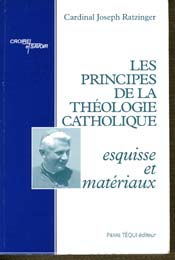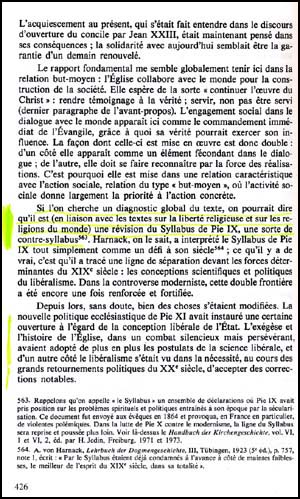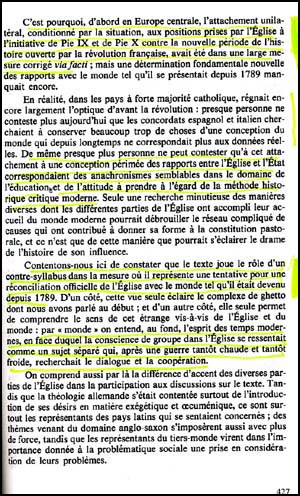Writing about the constitution Gaudium et spes, Card. Joseph Ratzinger described the new approach of the Conciliar Church toward the Modern World born from the French Revolution. The previous attitude of the Church was in accordance with the norms of Pope Pius IX listed in the Syllabus, which taught Catholics to combat the Liberalism of modernity.
Instead, Gaudium et spes advised Catholics to accept the Modern World as it is - certainly a revolution regarding the previous teaching. Hence Ratzinger approvingly defined Gaudium et spes as "a counter-Syllabus."
Top right is a picture of the book's cover; at right, photocopies of the French text. Below, we present our translation.
If one is looking for a global diagnosis of the text [of Gaudium et spes], one could say that it (along with the texts on religious liberty and world religions) is a revision of the Syllabus of Pius IX, a kind of counter-Syllabus ....
Undoubtedly, many things have changed since then. The new ecclesiastical policy of Pius XI established a certain openness toward the liberal conception of the State. In a silent but persevering combat, Exegesis and Church History increasingly adopted the postulates of liberal science; on the other hand, in face of the great political upheavals of the 20th century, Liberalism was obliged to accept notable corrections.
This happened because, first in central Europe, conditioned by the situation, the unilateral dependence on the positions taken by the Church through the initiatives of Pius IX and Pius X against the new period of History opened by the French Revolution was to a large extent corrected via facti. But a fundamental new document regarding relations with the world as it had been since 1789 was still lacking.
In reality, the mentality that preceded the revolution still reigned in the countries with strong Catholic majorities; today almost no one denies that the Spanish and Italian concordats [accords between Church and State] tried to conserve too many things from a conception of the world that for a long time had not corresponded to reality. Likewise, almost no one can deny that this dependence on an obsolete conception of relations between the Church and State was matched by similar anachronisms in the domain of education and the attitude taken toward the modern historical-critical method ....
Let us content ourselves here with stating that the text [of Gaudium et spes] plays the role of a counter-Syllabus to the measure that it represents an attempt to officially reconcile the Church with the world as it had become after 1789. On one hand, this visualization alone clarifies the ghetto complex that we mentioned before. On the other hand, it permits us to understand the meaning of this new relationship between the Church and the Modern World. "World" is understood here, at depth, as the spirit of modern times. The consciousness of being a detached group that existed in the Church viewed this spirit as something separate from herself and, after the hot as well as cold wars were over, she sought dialogue and cooperation with it.
(Les Principes de la Theologie Catholique - Esquisse et Materiaux, Paris: Tequi, 1982, pp. 426-427).
|



|

Posted on November 26, 2005
|
